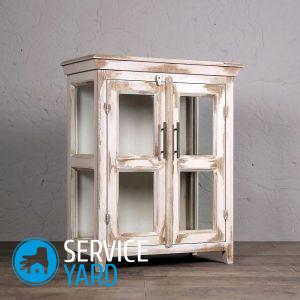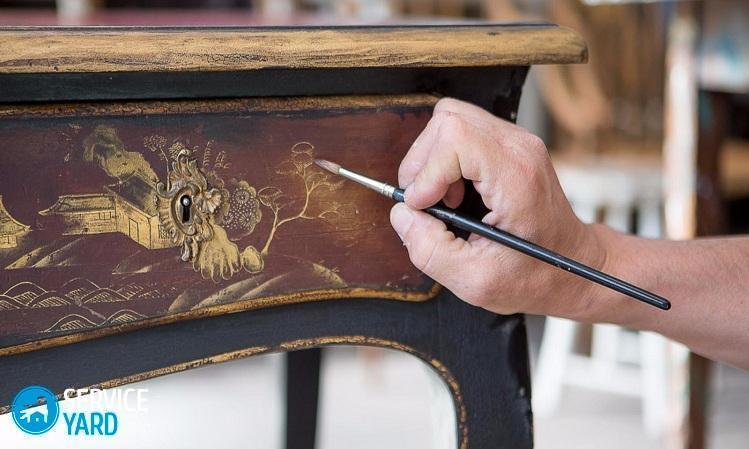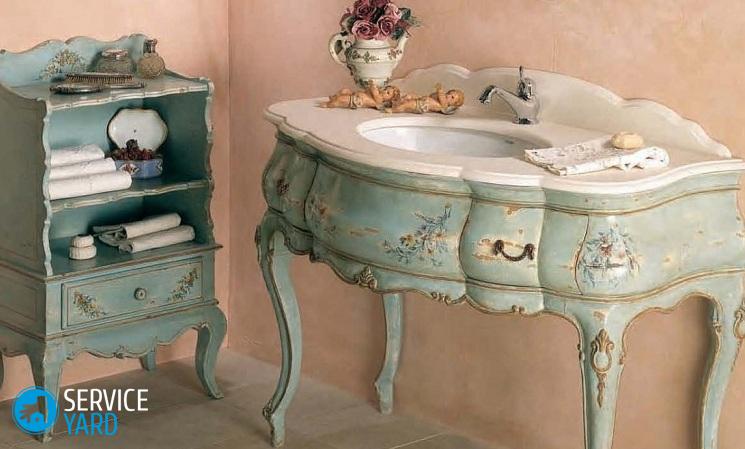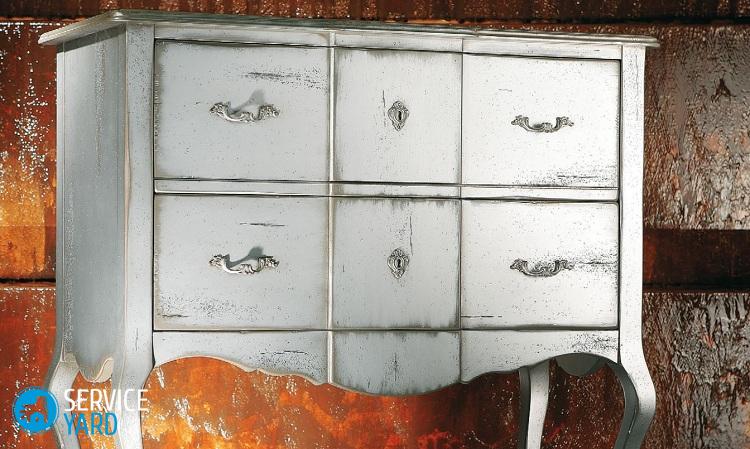How to age furniture at home?

Antique and antique products give the interior sophistication, chic, luxury and a special look. At the time of our grandmothers, we carefully tried to disguise scratches and abrasions on furniture so as not to give out her age. It was unlikely that anyone at that time knew that peeling paint would become the main trend in interior design, and many of us would think about how to age furniture at home to give the room a vintage look. Artificially aged wardrobe or chest of drawers gives the room an original style, character, personality, both in a modern apartment and in the interior in the style of Country, Provence or Shabby Chic. Today we will tell you how to age a cabinet with your own hands, so that it looks really beautiful and expensive. Indeed, for the result to be amazing, you need to know a lot of nuances. This is what we will talk about below.
to contents ↑How to give the furniture an old look?
Not every tree species can be given a spectacular appearance by aging. For antique decor elements, usually breed of high and medium softness, having an uneven density of fibers. Most conifers are perfect for this purpose:
- Pine.
- Spruce.
- Fir.
- Yew.
- Larch.
From hardwoods choose:
- Poplar.
- Alder.
- Lipu.
- Chestnut.
- Fruit trees.
Important! It should be noted that not all furniture is made of wood suitable for aging and brushing. In some cases, it is better to open the main parts with a moderately dark varnish and use overhead aged decors.
If the wood is suitable for quality, then it must be prepared for the process: lighten, remove all paints and varnishes and clean from greasy dirt and stains. To make it easier for you to perceive the whole process of “artificial aging”, we divided it into stages. Choose a simple wooden product for the experiment, be patient and follow our recommendations.
to contents ↑Stage number 1. Preparatory
To prepare the furniture for the aging process, follow these steps:
- Remove all handles and protruding decor elements.
- Free all drawers of the cabinet (chest of drawers) from things and fully pull them out.
- Remove old paint or varnish from the surface of the furniture until the texture appears with sandpaper.
Important! When removing old paints and varnishes, use a respirator to protect the respiratory system from dust.
- Wash too greasy areas of furniture with a solution of laundry soap.
- Dry the surface thoroughly.
Important! Polishing from old furniture can be removed manually or using special chemicals. Small cracks, crevices and other defects of the tree that appear do not need to be masked with putty. They will give a special flavor and emphasize the effect of aging.
For work, it is necessary to prepare special tools. For the procedure of painting and aging of wood you will need:
- Special paint for wood.
- Paint roller.
- Sandpaper, steel wool.
- Brushes.
- Craquelure varnish.
- Sticky gauze or napkin.
- Rags.
Advice:
- For home creative use, special chalk paints for wood are produced.The most suitable for beginners are Autentico or Annie Sloan.
Important! Chalk paints have a rich palette of shades, including blurry and imitating antiquities. Such paints are very convenient to use, they are applied immediately to the surface without additional primer treatment.
- If you decide to use regular water-based matte paints, you will need to pre-coat the wood surface with a water-soluble product. This is necessary for the best adhesion of the paint to the surface of the product and for the formation of a barrier against the penetration of oils from wood on the coating of the main paint.
There are about 10 basic ways to artificially age a tree. Each method is based on a specific technology and requires its own skills. Consider the simplest methods that can be applied at home.
to contents ↑Stage number 2. Choosing a way to age furniture
In order to age a wooden product, there are the following ways:
- Give the effect of peeling paint. For this, two shades of paint are used, one of which will be seen through cracks in another type of coating. The product will look as if it has been repainted repeatedly.
- Create abrasions on the product. When using this method, only one coat of paint is used.
- Brush or create a raised surface. The main work is carried out with metal brushes. The roughness and thickness of the brush pile is selected in proportion to the hardness of the tree species.
- Drawing a golden web. This method is quite simple to use and will appeal to everyone who admires the sophisticated and antique furniture. With it, you can quickly age furniture. It is only necessary to paint the product in the desired color (which you like), use a sponge to apply a golden color on an acrylic base. After the paint dries, the surface is varnished.
Stage number 3. Furniture aging
Depending on the method chosen, prepare all the necessary tools and get to work. We will tell you how to conduct the necessary activities step by step.
A way to help give your furniture a shabby look.
Step-by-step instructions on how to age furniture at home:
- Sand the product lightly.
- Wipe the subject with sticky gauze to remove the smallest particles of wood.
- Apply a base coat of paint (main). Paint with a paint roller. Start work from the back or inconspicuous sections of furniture to understand what shade the paint gives, how much it needs to be typed on the roller.
- Let the product dry well.
- Rub with a wax candle those areas of the surface of the product where you want the visible color to be visible.
- Apply a top coat of paint in a different shade (lighter).
- Let the product dry thoroughly.
- Wipe the areas where you applied wax with steel wool.
- On the corners, legs, horizontal surfaces and in places where hands touch, sand the paint to create the effect of a bare tree.
- Wipe the furniture with a sticky cloth and apply varnish if necessary.
- Chic antique furniture is ready.
Important! To make the result more interesting, we advise you to take note of the following recommendations:
- Before the dyeing process, cover the work area with newspapers or polyethylene. If possible, work outdoors for convenience and safety.
- During painting, roll the roller wide so that there are no drips. If drips nevertheless have formed, then sand them with sandpaper, and then apply a second coat of paint.
- To prevent the roller from drying out during painting breaks, dip it into a container of water.
- The easiest way to age furniture is to apply a single coat of paint through which the wood texture and its natural pattern will show through. The surface will look uneven and shabby.
A method that involves the use of craquelure for the effect of cracking of the paint layer
A grid of cracks can be obtained using special craquelure varnishes. With artificial aging, there are 2 ways to use craquelure:
- One step. In one-step, two layers of paint of contrasting colors are applied with an intermediate layer of craquelure varnish and drying. The upper layer of paint is cracked, as a result - the lower layer is exposed.
- Two-step craquelure. Two types of craquelure composition are applied with intermediate drying. After the top layer is cracked, dry pigments are rubbed into the cracks.
Important! This method is more time-consuming and is mainly used in arts and crafts and painting.
Step by step instructions for using paint and craquelure:
- Pick up paint of 2 colors - the main tone and lighter. For example, if you take contrasting colors: black and white, you get the effect of fading.
- Paint every detail of the design with the primary color.
- Wait for the paint to dry completely.
- Apply paint in a lighter tone.
- Wait for the paint coat to dry.
- Shake off the furniture dust and cover it with craquelure. The upper layer of paint of lighter tones will begin to crack, and the product will look as if it was painted more than once.
Important! To make the main color appear more saturated, carefully process the necessary parts of the product with sandpaper.
Brushing. Create a relief surface
This method can be used both separately and together with the other options listed above. For example, you can initially brush the surface, and then use a stain, paint or varnish.
Important! The process is based on a simple principle - soft wood fibers are removed using metal brushes, then holes are made using a drill or chisel, resembling wormholes. This must be done carefully so that the furniture remains as strong as ever.
Use this method for items made from the following types of wood:
- Teak.
- Cherry.
- Beech.
- Oak
- Maple.
- Pear.
- Ash.
- Larch.
To better understand this process, we recommend that you follow the instructions:
- Choose the softest layers of wood between hard fibers. To do this: consider a cross-section of the subject, thin hard fibers will alternate with wide soft ones. Only flat sections of the front of the furniture are aged.
- Pick up a metal brush - steel or brass. Brush roughness and pile thickness should be commensurate with the hardness of the wood species.
- Take a brush and treat the surface along the fibers. If you process the tree in the transverse direction, then dashes may remain on solid fibers, which will not look quite appropriate. Pull the brush along the entire workpiece with the middle clamp evenly. During processing, soft fibers inside the tree growth rings are easily erased, while knots and hard fibers remain. As a result, a microrelief is created on the surface.
Important! It is very important to stop in time during surface treatment. Relief should not be very pronounced. The optimal furrow depth is not more than 2 mm.
- Treat the surface with a nylon or sezal brush-brush. Their pile contains abrasive particles. When aging in natural conditions, the tree becomes smooth and pleasant to the touch, and after brushing there are burrs and a large number of thin rags that must be removed.
- Treat the wood with a fine sandpaper or synthetic brush. The wood will become more textured and the roughness inside the furrows will disappear.
- To completely smooth the relief, use fine abrasive powder or steel wool. Rub the wood with the selected product to a shine.
- Polish the surface with felt with a colorless abrasive paste applied to it. You can also use a nylon-skin on a foam base for polishing.
Important! All work on grinding and wood processing is carried out with gloves and a respirator so as not to breathe wood dust and not impose a splinter.
Varnish, stain or paint
After you have finished invoicing, proceed to the second stage - surface tinting.
Here are just a few recommendations on the use of materials with which you can age furniture at home:
- The easiest option is to open the surface with colorless varnish. Perform the procedure several times to protect against rot and dirt.
- A more pronounced effect of aging can be obtained by opening the tree with a stain. Select the depth of the material according to the type of wood. Thus, you will give the necessary contrast for the protruding grooves and ribs.
- To enhance the effect, wipe the stain immediately after application. Soft fibers absorb material more than hard ones, therefore they will be painted in a darker shade.
- If you thickly apply an opaque acrylic varnish with a brush, and then wipe it with a dry rag across the fibers, then it will remain only in deep veins. Coat solid fibers with dark polyurethane varnish using the swab method.
- If you want to make the tree gray, then use the remains of steel wool. Soak them in a cleaning solution containing hydrochloric acid for several hours to remove scale and limestone. Apply the liquid with a foam swab to the surface, wipe off any excess immediately, and dry the product at room temperature.
- Brushed wood can be patinated. Such furniture looks very impressive. For this procedure:
- Open the textured surface with one or two layers of varnish.
- Apply a small amount of glue to the surface.
- Apply copper foil.
- Remove excess with fine sandpaper.
- After the strips of copper remain only on the protruding solid fibers, wipe them with an etching chemical agent, lightly blow over with a gas burner.
to contents ↑Important! Here are a few additional tips to help you do all the work efficiently and beautifully, effectively age the furniture at home:
- A very high-quality and quick result of the selection of the texture is obtained by burning wood. In addition, under the influence of fire, the tree favorably changes color.
- For final processing, we recommend using a rotary grinder. Move the working part in a circle so as not to leave noticeable scratches.
- You can achieve the effect of patina with a special varnish containing metallized particles. Apply the composition with a wide fan, and rotate the workpiece at a slight angle.
Stage number 4. Final
The processed product must always be protected from all kinds of damage, thereby increasing its life. To do this, use the following materials:
- Wax for wood. It can be dark or transparent. Apply wax to furniture with a foam sponge or a lint-free smooth cloth.
- Protective varnish. It is better to use a matte acrylic varnish for wood.
And to complete the stage of artificial aging of furniture, update the furniture and complement the furniture with unusual accessories. Use a variety of vintage pens or hooks, other decorations.
to contents ↑Some subtleties of the procedure of aging furniture
Above, we talked about how to age furniture at home, and finally a few recommendations:
- It is best to focus on 4 different colors when painting. For example, the basic one is white, two bright shades and gray paint.
- Follow proper drying technology. Do not apply a new coat of paint unless the previous one is dry. It is best if the paint dries in natural conditions.
- Those areas that should look more shabby and old, rub with paraffin. Due to this, the paint will depart better.
- To create a worn effect, use a sponge to apply paint.
- If you use ordinary bitumen varnish as a patina, you can reduce the cost of the aging process.
- For the final effect of aging, 3-5 layers of paint are sufficient, no more.
- After drying all the layers of paint, sand the structure to clean it from excess layers of paint.
- To create the effect of volume and texture, as well as to achieve a certain relief, you can use putty. It is best applied with a gloved finger.
Stock footage
The effect of antiquity allows you to make a real masterpiece of art from any subject. But in order to choose the right one way or another, first read the photos of aged furniture, then - follow all the processes exclusively in a certain sequence, and your chic furniture will amaze everyone with its uniqueness and vintage!
- How to choose a vacuum cleaner taking into account the characteristics of the house and coatings?
- What to look for when choosing a water delivery
- How to quickly create comfort at home - tips for housewives
- How to choose the perfect TV - useful tips
- What to look for when choosing blinds
- What should be running shoes?
- What useful things can you buy in a hardware store
- Iphone 11 pro max review
- Than iPhone is better than Android smartphones






